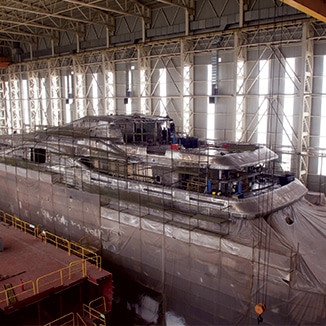

A recent article in Maritime Executive provides an interesting perspective on the nation’s shipbuilding industry, diving into the U.S. Department of Transportation’s Maritime Administration (MARAD) report, “The Economic Importance of the U.S. Shipbuilding and Repairing Industry,” for an optimistic view.
Things Are Looking Positive in the U.S. Shipbuilding Industry
- The U.S. shipbuilding and repair industry supports jobs in all 50 states with a total of more than 110,000 jobs nationwide and contributes $37.3 billion to the national GDP.
- Currently 124 shipyards in the U.S., spread across 26 states, are classified as active shipbuilders. Additionally, more than 200 shipyards are engaged in ship repairs or capable of building ships but are not actively engaged in shipbuilding.
- Despite an increase in foreign competition, exports by U.S. shipbuilders have strengthened in recent years, rising to $1.2 billion in 2014 (representing 4.6 percent of industry revenues). As a result, the U.S. shipbuilding industry has run a trade surplus in six out of the last nine years and a cumulative trade surplus of $1.5 billion over this period.
Demand for Energy-Related Vessels Drives the Shipbuilding Industry
Independent research analyst IBISWorld has pegged the sector’s employment numbers at levels equivalent to the MARAD report, though it assesses revenues at a lower level ($26 billion). Their analysis of past performance and industry trends seems to fall between the perspectives of the two maritime publication articles:
Over the past five years, the shipbuilding industry has slowly sailed rough seas as demand from the military and commercial markets fluctuated. As a result of pressured military funding and recession-induced commercial backlog decline, demand for shipbuilding declined in the early part of the five-year period. However, the boom in U.S. oil and natural gas production has recently led to a surge in demand for energy-related vessels. Over the next five years, the industry is anticipated to catch more wind from renewed funding for military ships and continued demand for energy industry-related vessels. As the U.S. Navy attempts to meets its objective of creating a fleet to meet the challenges of the coming years, demand for new naval vessels will rise…
With more than 70 percent of shipbuilding industry revenue tied to the defense sector, it’s clear that defense funding and spending will have the greatest impact on shipbuilding activity moving forward. Having the ability to deliver on time and on budget will provide shipbuilders an advantage as they pursue these contracts. Shipbuilders and repair firms that do this most successfully will leverage the latest technology to manage the complex manufacturing at the core of their businesses.
Download our free eBook on What is MES and how it can help in complex discrete manufacturing.
For more information, download the iBase-t Shipbuilding Solutions Overview.



